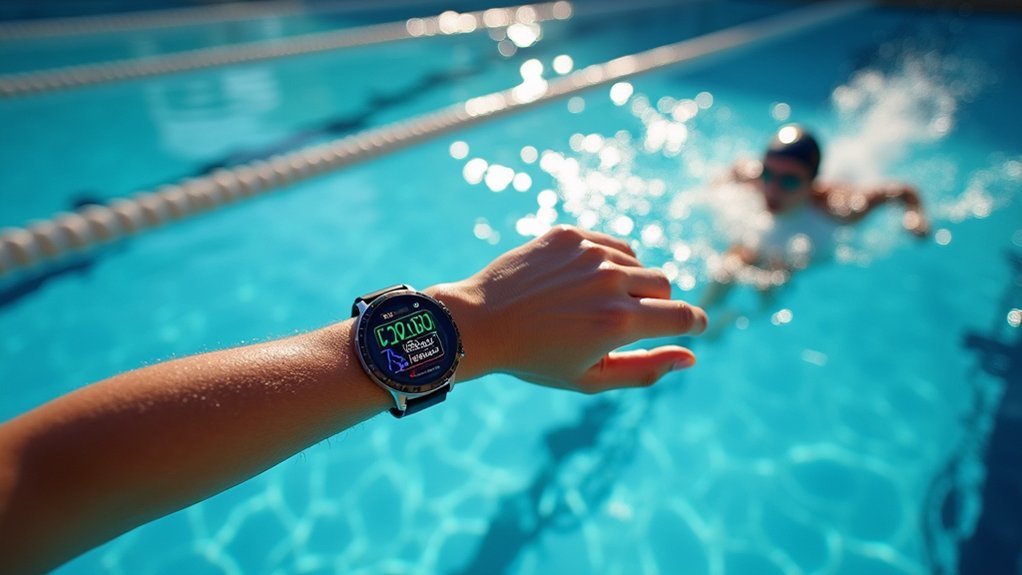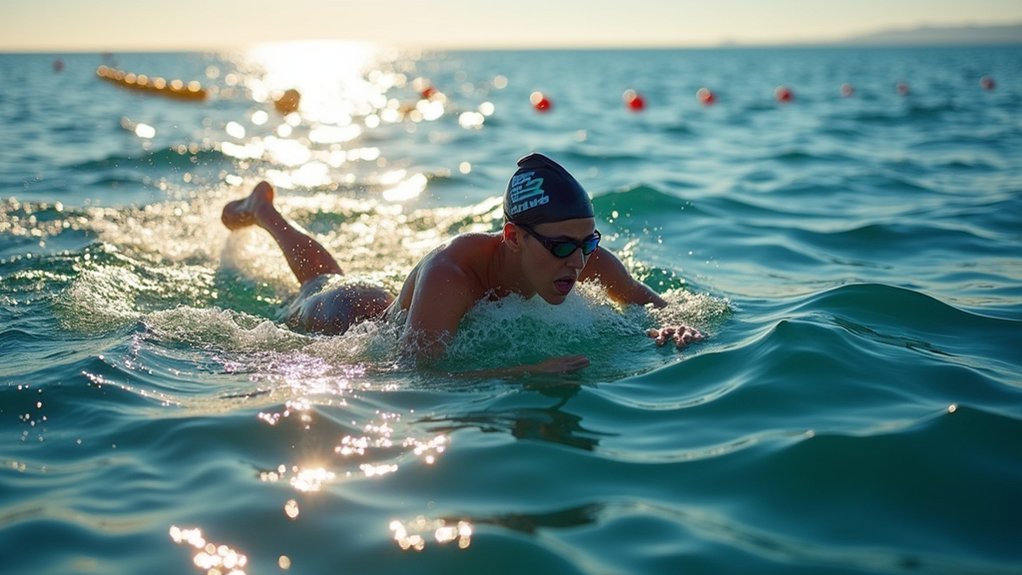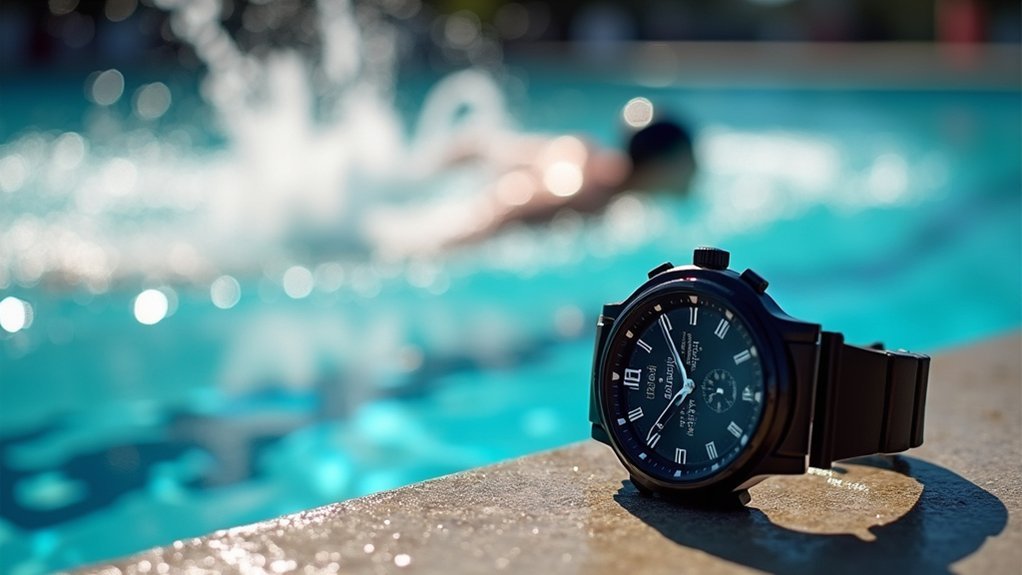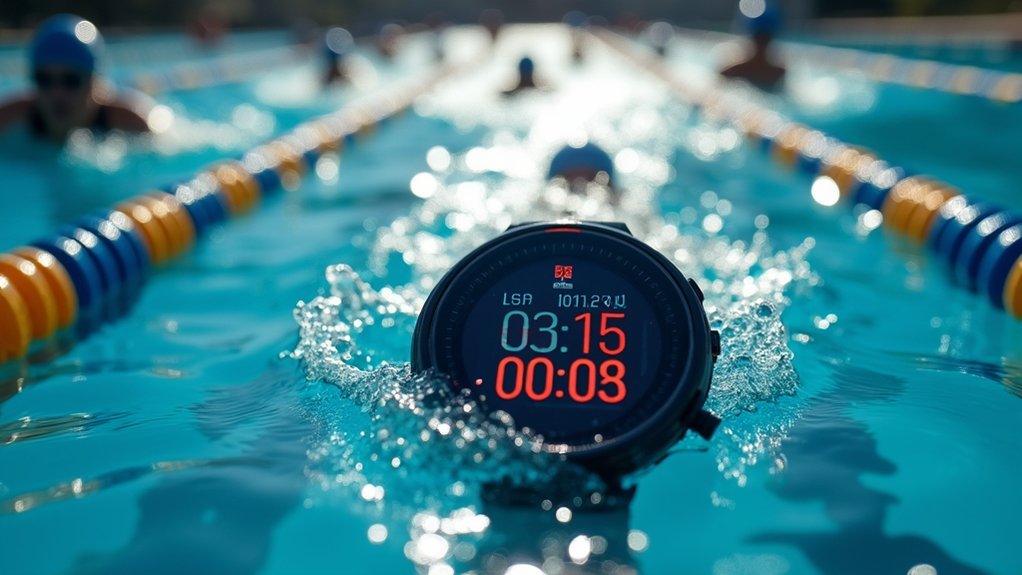Waterproof swim watches eliminate the mental burden of counting laps while providing essential performance metrics like stroke efficiency, pace, and SWOLF scores. You’ll get real-time feedback that helps you adjust your technique and prevent burnout during intense sessions. These devices combine advanced sensors with sophisticated algorithms to track your unique swimming patterns accurately in both pool and open water environments. The detailed analytics transform ordinary swims into structured training opportunities for continuous improvement.
Why Track Swimming Laps With Waterproof Watches?
How often have you lost count of your laps while swimming, disrupting your workout flow and diminishing your training effectiveness? Waterproof swim watches eliminate this frustration by providing accurate lap counting regardless of pool size, thanks to customizable pool length settings.
These devices do far more than count laps—they identify your specific swimming strokes, measure efficiency through SWOLF scores, and track critical metrics like distance, pace, and heart rate.
Modern swim watches analyze your technique, efficiency, and performance metrics—delivering insights far beyond basic lap counting.
You’ll gain insights into your performance with detailed time and split analysis, helping you pinpoint areas for improvement.
For open water swimmers, GPS functionality tracks routes and speeds when your arm breaks the surface. Most swimmers prefer Garmin watches (65%) for their robust design and excellent GPS tracking in open water environments.
With durable, water-resistant construction, these watches withstand the aquatic environment while offering user-friendly interfaces that won’t interrupt your swimming rhythm.
The Science Behind Accuracy in Lap Detection
Modern swim watches leverage multi-sensor fusion, combining accelerometers that track wrist velocity with gyroscopes that measure rotation to identify different stroke types with remarkable precision.
These devices run sophisticated algorithms that can distinguish between actual swimming motions and false movements like adjusting goggles or pausing at the wall, greatly reducing counting errors that plagued earlier generations of trackers.
You’ll find the most accurate watches employ machine learning models that adapt to your unique swimming patterns over time, creating a personalized profile that improves detection with each session. Studies show that premium options like the Apple Watch provide highly accurate tracking, missing only 1-2 lengths during extensive training sessions.
Sensor Technology Innovations
While swimmers glide through water focusing on technique and endurance, sophisticated sensor arrays inside their waterproof watches work tirelessly to track every movement with remarkable precision.
Modern watches integrate multi-axis accelerometers, gyroscopes, and magnetometers that together capture your swimming motion in real time with extraordinary detail.
These technological marvels offer innovations that were unimaginable just years ago:
- Sensor fusion algorithms that combine data from multiple sensors, reducing noise for more accurate lap counts
- Pressure sensors that differentiate between surface movements and actual underwater turns
- Advanced waterproofing certified for depths up to 50 meters with chlorine-resistant coatings
- On-device signal processing that enables longer battery life and real-time feedback
Your watch doesn’t just count laps—it’s an all-encompassing swimming performance laboratory on your wrist. The best models can calculate SWOLF scores to help swimmers identify areas for improving their stroke efficiency and technique.
Algorithmic Stroke Recognition
The remarkable accuracy of today’s swim watches stems from sophisticated algorithms that interpret raw sensor data into meaningful swimming metrics. Your watch distinguishes between freestyle, breaststroke, butterfly, and backstroke by identifying unique acceleration patterns produced by each stroke type.
Advanced neural networks achieve up to 97.4% stroke recognition accuracy and 99.2% lap counting precision by analyzing motion signatures in your swimming movements. These algorithms employ classification trees and other modeling techniques developed from thousands of sample workouts. These systems detect critical shifts during turns and stroke changes, maintaining accuracy even when you’re resting or changing techniques.
While accelerometers provide primary data, many watches integrate barometric and light sensors for enhanced environmental awareness.
The technology continuously improves through machine learning trained on diverse swimmer data, adapting to your personal technique regardless of skill level or swimming style variations.
Error Mitigation Systems
Despite their seemingly simple task, accurate lap counting systems rely on sophisticated error mitigation techniques that distinguish genuine lap completions from false readings. Your watch employs multiple layers of technology to guarantee reliable tracking during your swim sessions.
These systems filter out the noise and focus on meaningful data through:
- Data smoothing algorithms that reduce sensor inconsistencies
- Motion filtering that eliminates false positives from non-swimming movements
- Calibration protocols that maintain accuracy across different pool conditions
- Machine learning systems that adapt to your personal swimming style over time
As you swim, these error mitigation systems work silently in the background, constantly analyzing accelerometer and motion sensor data to deliver the accurate lap counts you need for effective training analysis. Much like how state-of-the-art object recognition software enables SwimEye to monitor underwater video footage for safety purposes, your watch uses advanced pattern recognition to ensure reliable performance.
Eliminating Mental Counting Errors During Intense Swims
Many dedicated swimmers face a common frustration when pushing their limits in the pool: losing track of completed laps. When you’re focused on technique, breathing, and pacing during high-intensity workouts, mental counting becomes an unwelcome distraction that often leads to errors. Smart swim goggles like FORM provide heads-up display that eliminates the need to pause and check your progress.
| Mental Counting Challenges | Impact on Performance | Watch Solution |
|---|---|---|
| Fatigue reduces focus | Compromised technique | Automatic tracking |
| Monotony causes lapses | Uncertain training data | Real-time feedback |
| Mid-stroke disruptions | Rhythm breakdown | Continuous monitoring |
| Stress affects accuracy | Under/overtraining risk | Historical data capture |
Personalized Pace Analysis for Performance Optimization

Your waterproof watch provides real-time feedback that lets you adjust your pace during swims, preventing burnout in early laps and maximizing performance when it counts.
By tracking your splits across different distances, you’ll identify patterns that can refine your race strategy for competitions.
These personalized insights transform your training sessions into structured opportunities for improvement, helping you develop the ideal pacing for your specific swimming events. Advanced models like the Garmin Fenix 8 and Apple Watch Ultra 2 can track your SWOLF measurements underwater, giving you accurate efficiency metrics that improve your technique.
Real-Time Pace Adjustments
Real-time pace adjustments represent one of the most valuable features in modern waterproof swim watches, enabling swimmers to monitor and enhance their performance during workouts rather than solely analyzing data afterward.
Your watch’s accelerometer and gyroscope work together to track motion and identify stroke types for precise analysis.
- Immediate Feedback – Receive alerts when you drift from target pace, allowing you to make instant corrections to maintain peak performance
- Stroke-Specific Data – Adjust your technique based on efficiency metrics like SWOLF, tailored to different stroke types
- Visual Guidance – Glance at charts and graphs that visualize your pace trends during rest intervals
- Customizable Alerts – Set personalized pace thresholds that vibrate or flash when you need to speed up or slow down
Advanced models like the Garmin Swim 2 offer exceptional GPS accuracy for open-water swimmers who need reliable distance and route tracking during training sessions.
Race Strategy Refinement
While real-time feedback helps during swims, race strategy refinement transforms your accumulated data into an all-encompassing performance blueprint. Your waterproof watch captures essential metrics that reveal personalized pacing patterns across different race segments.
By analyzing your effort distribution, you’ll identify where to conserve energy and when to push harder. Your watch data highlights stroke efficiency variations, turn execution quality, and cycle rate patterns—all vital factors in optimizing race performance. Complementing your watch data with swim video analysis provides comprehensive insights into your technique from multiple angles.
Understanding your depth control tendencies can further reduce resistance forces that slow you down.
With consistent tracking, you’ll develop segment-specific strategies tailored to your unique strengths. This personalized approach eliminates guesswork, replacing it with data-driven decisions that enhance performance while minimizing injury risk.
Your watch becomes the cornerstone of long-term performance optimization through systematic, individualized race strategy refinement.
SWOLF Score: The Ultimate Efficiency Metric for Swimmers
When competitive swimmers seek to measure their technical efficiency in the water, they often turn to the SWOLF score—a powerful metric that combines stroke count and time.
This “swim golf” calculation delivers a clear picture of your swimming efficiency, with lower scores indicating better performance.
Modern waterproof watches make tracking this essential metric effortless, allowing you to:
- Monitor your efficiency by calculating SWOLF = time in seconds + stroke count per lap
- Compare your scores across different sessions (35-45 for 25m is considered good)
- Identify technique improvements that reduce your stroke count while maintaining speed
- Conserve energy during races by optimizing your swimming mechanics
Maintaining a proper streamline and implementing strong underwater kicks after push-offs are crucial techniques that can significantly improve your SWOLF score over time.
Open Water Navigation and Route Optimization

Unlike pool swimming with its clear lane lines, open water navigation presents unique challenges that demand both skill and strategy.
You’ll need to master efficient sighting techniques—lifting your eyes just above water every 8-12 strokes while maintaining stroke rhythm and minimizing drag.
Your waterproof watch becomes invaluable in open environments, offering GPS tracking and compass features that reduce the need for frequent head lifts.
These devices provide real-time directional feedback and route data you can analyze post-swim.
To optimize your route, balance the shortest path with environmental factors like currents and waves. Incorporating a fixed point focus on landmarks or buoys significantly improves your navigation accuracy while swimming.
Adjusting your stroke rate helps maintain course against external forces, while using fixed landmarks as reference points prevents unnecessary deviations.
Advanced swimmers combine bilateral breathing with strategic sighting to simultaneously navigate and breathe without disrupting efficiency.
Heart Rate Monitoring in Aquatic Environments
Heart rate monitoring represents one of the most significant challenges for swimmers and their waterproof devices.
Water interference between your skin and sensors disrupts optical HRMs, while chest straps fail as water absorbs Bluetooth signals.
Despite these obstacles, tracking your heart rate while swimming provides vital data for optimizing performance and preventing overtraining.
- Training precision – Use Karvonen method adaptations to calculate accurate heart rate zones specifically for aquatic workouts
- Real-time feedback – Monitor how your body responds to water temperature and chemical exposure during sessions
- Performance optimization – Adjust stroke efficiency based on heart rate data to conserve energy
- Recovery assessment – Track heart rate trends across swim sessions to identify potential overtraining risks or fitness improvements
Several manufacturers have developed innovative solutions including temple-based sensors that provide reliable readings even in challenging swimming conditions.
Building Progressive Training Plans With Swimming Data

Transforming raw swimming metrics into structured, progressive training plans represents the true value of waterproof watches for serious swimmers.
By starting workouts at 60-70% of your maximum effort, you’ll establish a sustainable baseline that prevents burnout. Your watch data enables you to incrementally increase volume or intensity weekly, following the progressive overload principle that drives improvement. Utilizing this approach helps avoid the performance stagnation experienced by approximately 95% of swimmers who follow generic programs.
Track pace consistency, rest intervals, and distance to make evidence-based adjustments to your training load. Structure your 2-3 weekly sessions with balanced progression, incorporating technique drills, endurance sets, and speed intervals based on your recorded metrics.
Use periodization to alternate focus between different swimming aspects while strategically scheduling recovery days. Regular assessment swims calibrated through your watch data guarantee you’re making ideal progress toward your swimming goals.
Comparing Pool Sessions vs. Open Water Performance
Your swimming watch handles pool workouts and open water swims differently, producing data that isn’t always consistent between these environments.
You’ll need to adapt your training plans for each setting, recognizing how controlled pool metrics differ from the variable conditions of open water performance. The waterproof design ensures you can confidently use your device in both environments without worry of damage.
Developing navigation skills becomes particularly essential for open water swimming, as your watch’s GPS tracking depends on your technique and ability to periodically expose the device to satellite signals.
Data Consistency Across Settings
While tracking your swimming performance seems straightforward, the accuracy and consistency of data vary considerably between controlled pool environments and unpredictable open water settings. Your watch delivers more reliable metrics in pools where sensors can accurately count laps and detect stroke types without GPS interference.
Here’s what affects your data consistency:
- Pool settings utilize accelerometers for precise lap counting, while open water relies on intermittent GPS signals that reconnect only when your wrist breaks the surface. The Apple Watch Series 8 utilizes accelerometer and gyroscope technology for exceptional accuracy during swim tracking.
- Stroke recognition works better in controlled pool environments than in variable open water conditions.
- Distance tracking is more accurate in pools (fixed length) compared to GPS-dependent open water measurements.
- Performance feedback comes immediately in pools but may be delayed in open water due to signal limitations.
Tailored Training Adaptations
The fundamental differences between pool and open water environments require specifically tailored training approaches for peak performance.
Your waterproof watch adapts to both settings—tracking structured laps in pools while using GPS to measure routes in open water.
In pools, you’ll benefit from precise interval training using constant depth and lane dividers. Your watch counts laps accurately and analyzes flip turns to improve technique.
The controlled environment allows for focused SWOLF score improvement and structured workouts.
Open water swimming presents different challenges, requiring navigation skills without visual cues.
Your watch’s GPS becomes essential here, helping you adapt to currents, waves, and depth variations.
These unpredictable conditions demand different pacing strategies and awareness of safety considerations.
Each environment offers unique training benefits that your waterproof watch can help optimize.
Optimizing Navigation Skills
Steering effectively through water presents distinct challenges depending on your swimming environment, which is why modern waterproof watches offer specialized features for both settings.
While pool swimming relies on accelerometers for tracking laps and strokes, open water navigation demands GPS functionality to monitor your location and distance accurately.
- Technology Distinction – Pool watches track turns and strokes with motion sensors; open water devices use GPS and algorithms to estimate position when signals drop underwater
- Skill Development – Pool training builds technique and muscle memory; open water improves navigation and adaptability
- Data Application – Pool metrics focus on personal performance; open water data emphasizes navigation and route efficiency
- Investment Consideration – Open water tracking requires pricier devices with advanced features, while pool-only swimmers can choose more affordable options
Technical Durability: What Makes a Watch Truly Waterproof
Understanding what makes a swimming watch genuinely waterproof involves more than just marketing claims. It’s about technical standards and physical construction working together to protect your device.
Water resistance ratings tell you exactly what your watch can handle: 50M for basic swimming, 100M for regular pool sessions, and 300M for diving (when ISO 6425 certified). These aren’t permanent features—they deteriorate over time.
The true durability comes from quality seals, gaskets, and crown protection that prevent water penetration at vulnerable points. Materials like stainless steel and specialized crystals withstand pressure while maintaining integrity. The Apple Watch Series 9 maintains a 50 meters rating under the ISO standard 22810:2010 for water resistance.
Don’t be fooled by impressive numbers alone. Regular maintenance, testing, and following manufacturer guidelines guarantee your watch remains waterproof through countless swimming sessions, giving you reliable lap tracking when you need it.
Recovery Insights Through Post-Swim Analytics

While most swimmers focus primarily on performance metrics, modern waterproof watches now offer sophisticated recovery analytics that transform how you approach post-swim restoration. Your watch becomes a personal recovery coach by monitoring stroke efficiency through SWOLF scoring and identifying heart rate zones to prevent overtraining.
- Track pace consistency to uncover endurance gaps requiring targeted recovery strategies.
- Monitor stroke rate variability to detect early signs of muscle fatigue before they become injuries.
- Optimize rest intervals by comparing recovery periods between sets with actual performance improvement.
- Analyze workout load through cumulative heart rate data to guarantee your training plan maintains proper balance.
Advanced watches even sync with sleep trackers, correlating swim intensity with recovery quality to help you fine-tune rest periods between demanding sessions. Devices like those supported by Garmin Connect allow swimmers to create personalized swim workouts that are specifically designed to incorporate appropriate recovery phases based on individual fitness levels.
Multi-Sport Integration for Triathletes and Cross-Trainers
For triathletes and cross-training enthusiasts, waterproof watches have evolved far beyond simple lap counters into all-encompassing multi-sport command centers.
Today’s devices seamlessly sync your swim data with running and cycling metrics, automatically recognizing shifts between activities during competitions.
These watches deliver unified training load metrics across disciplines, preventing the common pitfall of overtraining.
You’ll benefit from workout customization for brick sessions and cross-analysis tools that compare swim efficiency to running cadence or cycling power.
GPS-enabled tracking works in both pools and open water, with many watches offering tidal data integration and shift-ready durability up to 20 ATM.
Quick-release bands accommodate wetsuits, while synchronized heart rate zones and sport-specific power balancing guarantee your training remains precisely calibrated across all three triathlon disciplines.
The Garmin Fenix 6X Pro offers exceptional versatility with its standalone swim functions and rugged design that withstands the demands of multi-sport training.
Stroke Analysis and Technique Improvement Features
Modern waterproof watches now serve as your personal swimming coach, offering detailed stroke analysis capabilities beyond the multi-sport features triathletes rely on.
These sophisticated devices transform raw data into actionable insights that help refine your technique and boost efficiency in the water. The accuracy of these devices in open water can vary significantly, with the best models achieving accuracy within +/- 1 to 3% of actual distance.
- Real-time feedback on stroke symmetry, rotation, and pattern irregularities alerts you to fatigue-induced form issues before they impact performance.
- SWOLF scoring combines stroke count with lap time to measure efficiency, tracking improvements as you refine your technique.
- Force and propulsion metrics identify energy-wasting movements by analyzing your distance per stroke and power output.
- Video synchronization overlays your performance data onto footage, allowing frame-by-frame analysis of your stroke execution compared to ideal form.
Frequently Asked Questions
Do Waterproof Watches Interfere With Natural Swimming Technique?
No, waterproof watches won’t interfere with your natural swimming technique. They’re designed to be lightweight and non-obtrusive. As long as you’ve properly fitted your watch, you’ll maintain your normal stroke mechanics while swimming.
How Long Do Waterproof Watch Batteries Last During Swim Tracking?
Waterproof watch batteries typically last 5-7 days, but only 5-10 hours when actively tracking swims. You’ll get less battery life using GPS for open water swimming than pool tracking without GPS.
Can Waterproof Watches Track Swimming in Saltwater Hot Springs?
Most waterproof watches can track swimming in saltwater hot springs, but you’ll need to check your specific model. Saltwater and heat can damage some watches, so rinse it thoroughly afterward to prevent corrosion.
Are Waterproof Watches Suitable for Competitive Swimming Events?
Yes, you’ll find waterproof watches extremely suitable for competitive swimming. They offer 5+ ATM ratings, track essential metrics like laps and stroke types, and withstand pool chemicals while providing real-time performance data during events.
Can Children Use Waterproof Watches to Track Their Swimming Progress?
Yes, your child can use waterproof watches designed specifically for kids to track swimming progress. They’ll enjoy features like lap counting, stroke recognition, and real-time feedback that make monitoring their improvement fun and engaging.
In Summary
By tracking your swimming with a waterproof watch, you’re not just counting laps—you’re revealing a wealth of performance data. You’ll eliminate counting errors, optimize your pace, and improve technique through stroke analysis. Your SWOLF score will highlight efficiency gains while durability features guarantee reliability lap after lap. For serious swimmers and triathletes, it’s an investment that transforms your training from guesswork to precision.





Leave a Reply